With proper and thoughtful design, incentive and reward programs, can be very effective in facilitating engagement.
When discussing how we can apply rewards structures to design, what we most often talk about is the application of extrinsic rewards: How we can motivate people to carry out specific actions, with he use of money, praise, grades, prizes, highscores, points, and ranks. However, what is most often missing from the discussion is our intentions – are we looking for a quick fix or a longer lasting behavior change?
Where extrinsic rewards operate outside the individual and are related to actions that can be measured in monetary terms, intrinsic rewards operate within the individual rather than relying on any external pressure. Where the means of extrinsic rewards is money, praise, prizes, highscores, points, and ranks, examples of intrinsic rewards are such as “conducting meaningful work”, when a tasks provides a “feeling of well-being”, experiencing “pleasure from helping someone in need”, and the “personal satisfaction of a job well done”.
Intrinsic rewards go toward mastery on the longer term rather than instant gratification in the short term. The motivational effect of extrinsic rewards tend to wear out much faster than intrinsic rewards.
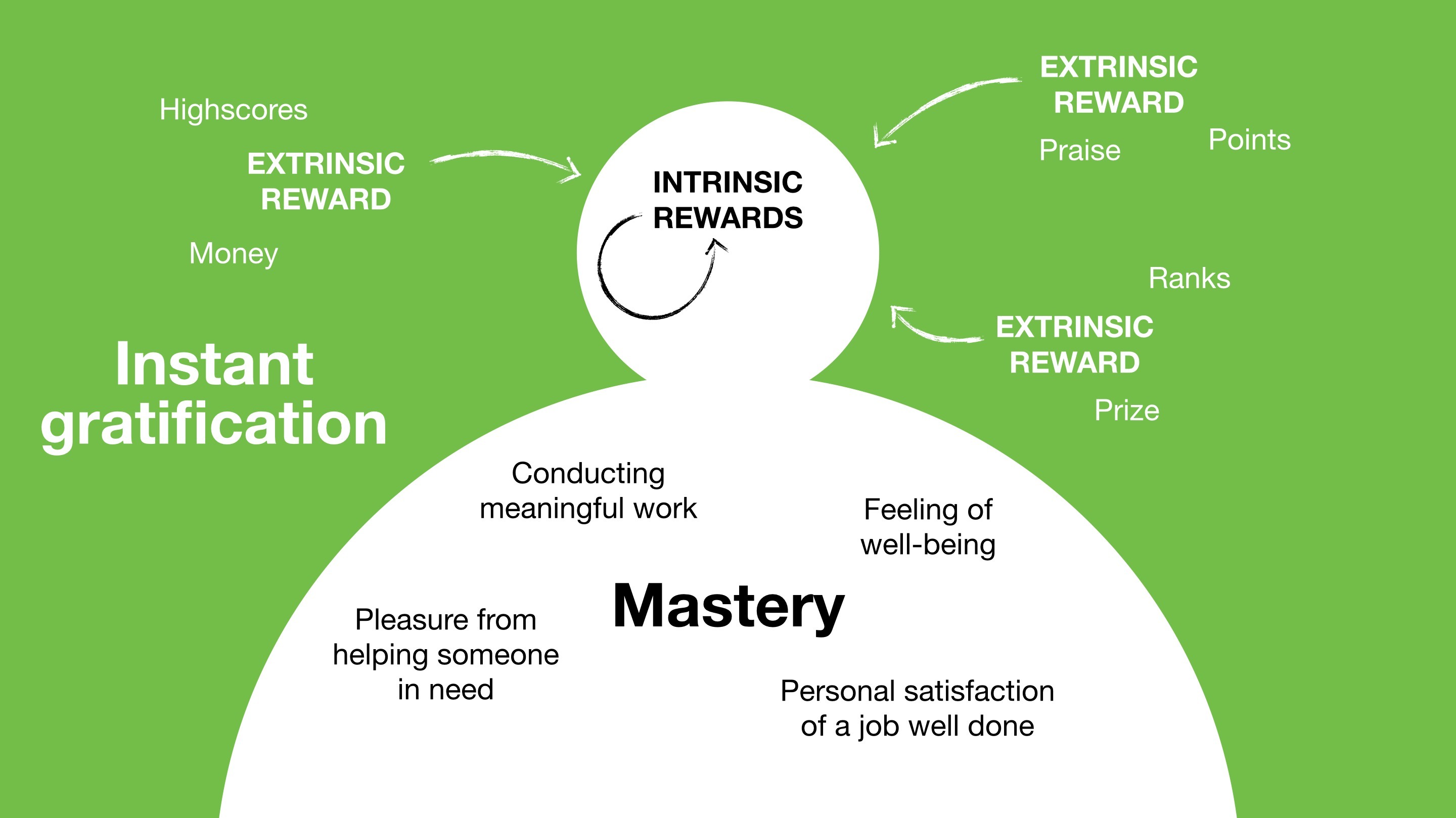
When we talk about rewards being able to motivate behavior, we should rather focus on how rewards can facilitate behavior that will lead to intrinsic rewards such as mastery, recognition, and personal growth.
This is why when we talk about rewards being able to motivate behavior, we should rather focus on how rewards can facilitate behavior that will lead to intrinsic rewards such as mastery, recognition, and personal growth. Choosing appropriate reward structures, depend on the social structures of your service. Especially when designing for communities, rewards should be aligned with its social structures.
The competitive spectrum
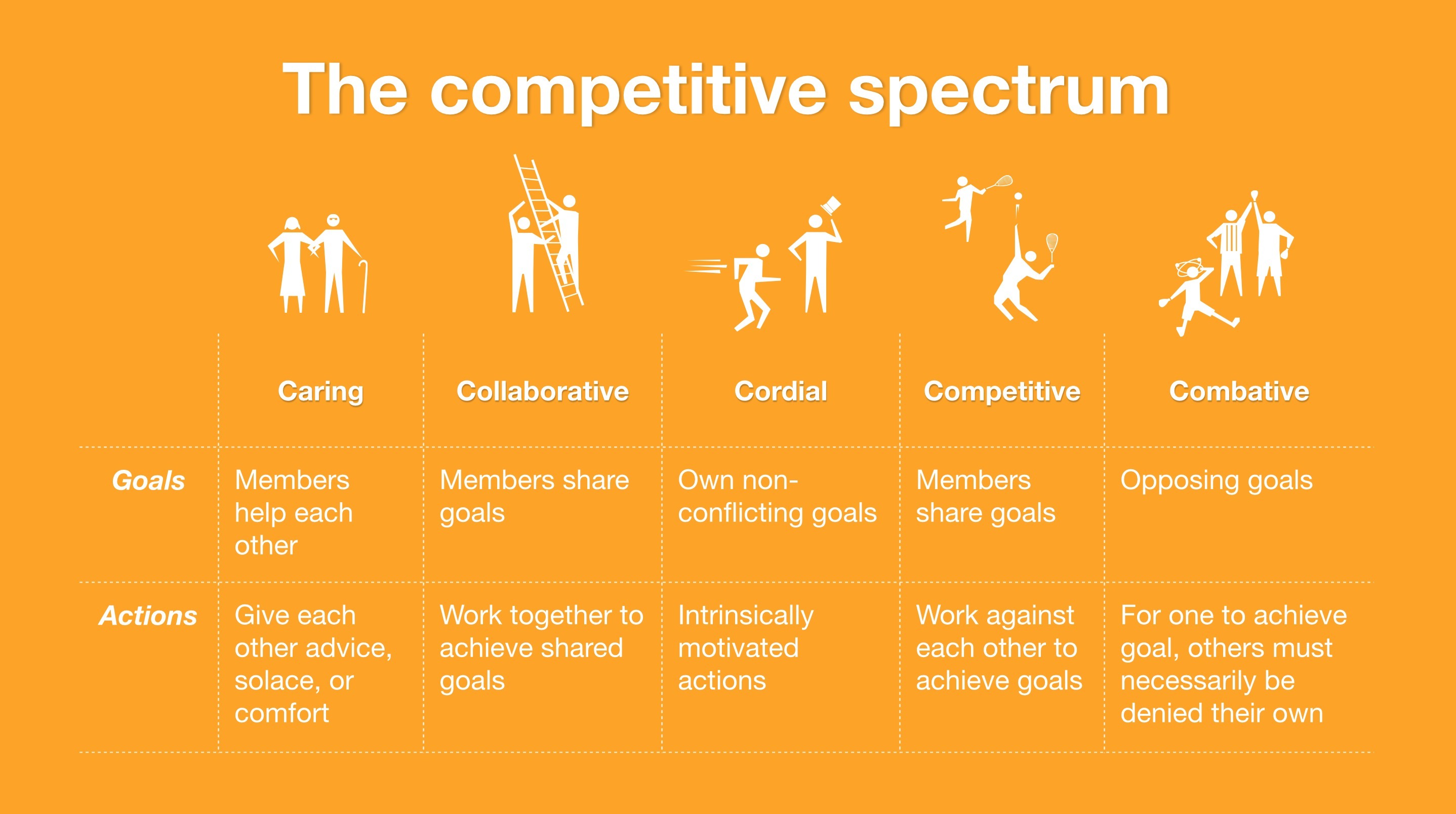
The competitive spectrum
In communities, users can be rewarded for working together as a group or excelling as individuals.
In a competitive community, users share the same goals, but must compete against each other to achieve them, whereas in a collaborative community, users work together to achieve the same goals. Users in the competitive community are motivated by extrinsic rewards such as accomplishments, points, levels, rank, or anything that can be used to establish their bragging rights.
In the collaborative community it is the more intrinsic rewards that should be focused on, such as meaningfulness, reputation, or personal satisfaction of a job well done.
Studies show that rewarding competitive actions accentuates users’ perceived difference between themselves and other users in the community, whereas rewarding collaborative actions minimizes perceived differences between the user and other users of a community.
Social structures aren’t always as simple as either being collaborative or competitive. Communities are also built around users caring for each other, helping, or even being combative toward each other. Learn more about the competitive spectrum at the Yahoo Design Pattern Library.
Planning rewards
There are two elements of a reward, that need careful planning:
- when a reward is given out and
- what the reward is
As the timing of the reward is important, so is the nature of the reward. Ultimately, the goal of the reward, is to maximize motivation prior to receiving the reward, as well as happiness after receiving the reward.
Rewards do not have to be monetary and quantifiable, but can also facilitate more intrinsic motivations. Let’s take a look at, how rewards can be shaped.
Kind of reward
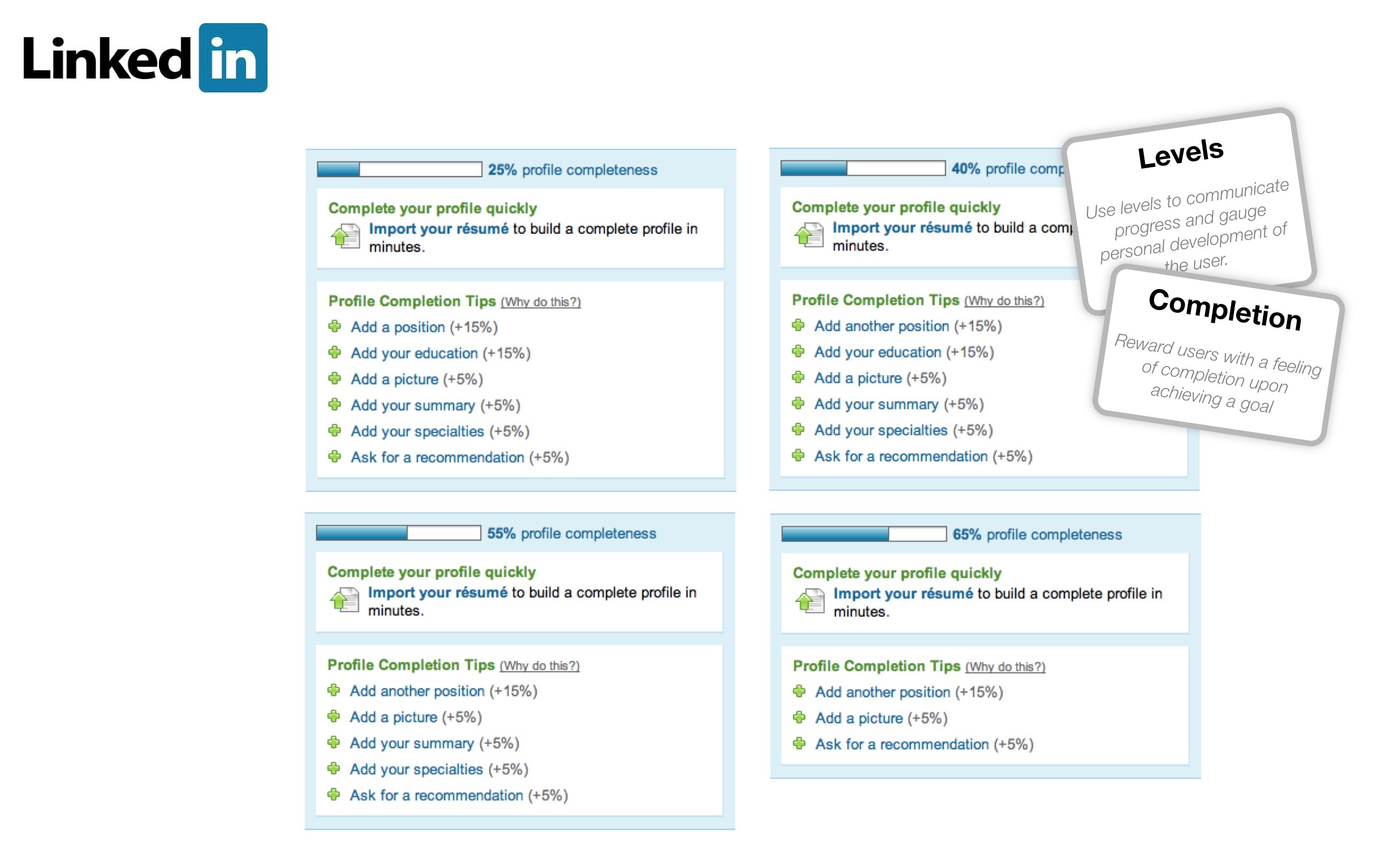
Rewards applied at LinkedIn
A classic example of applying rewards to web design is the early version of LinkedIn. Here a box in the sidebar showed a progress meter depicting how complete your profile was. By just doing this one little thing, you can be more complete and have a greater percentage of completeness. Being presented to this box, most people play along until well over 50%. Two forms of rewards patterns was used in this example:
- Levels – and the reward of feeling progress
- Completion – the feeling of resolving an uncompleted dissonance.
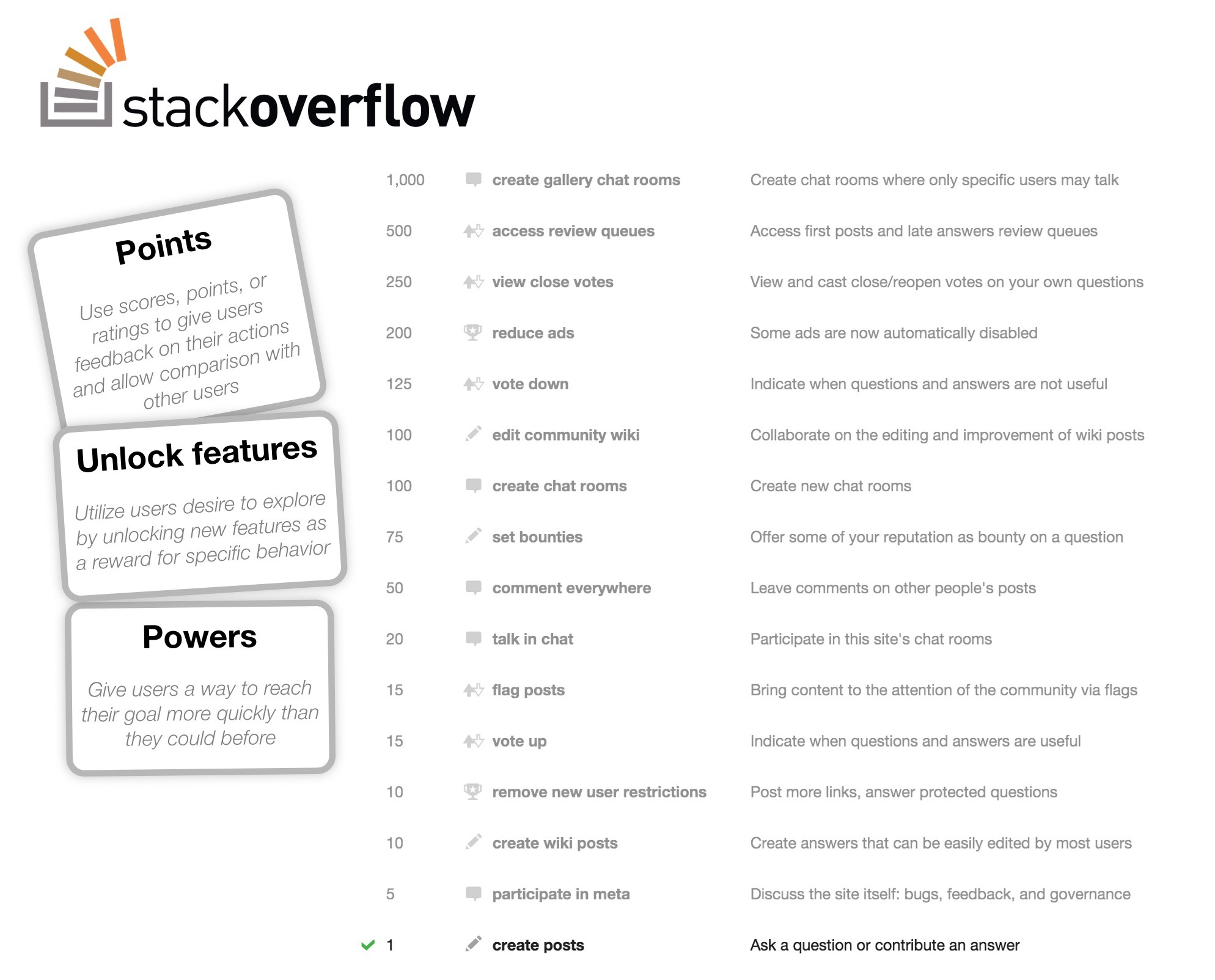
Community participation and good deeds are rewarded with reputation points at StackOverflow.com.
Community participation and good deeds are rewarded with reputation points at StackOverflow.com – a question and answer site for programmers. As your reputation points rise new features are unlocked. Chat rooms are unlocked and ads are disabled. Some of the unlocked features allow users to do more than other users, empowering them to create chat rooms of set bounties.
Timing of rewards
The other element of a reward, that need careful planning is when a reward is given out. When and how often we reinforce a behavior can have a dramatic impact on the strength and rate of the response
When using continuous reinforcement, the desired behavior is reinforced every single time it occurs. All of the examples we just went through uses continuous reinforcement, as there was a direct and immediate correlation between an action and the corresponding reward received.
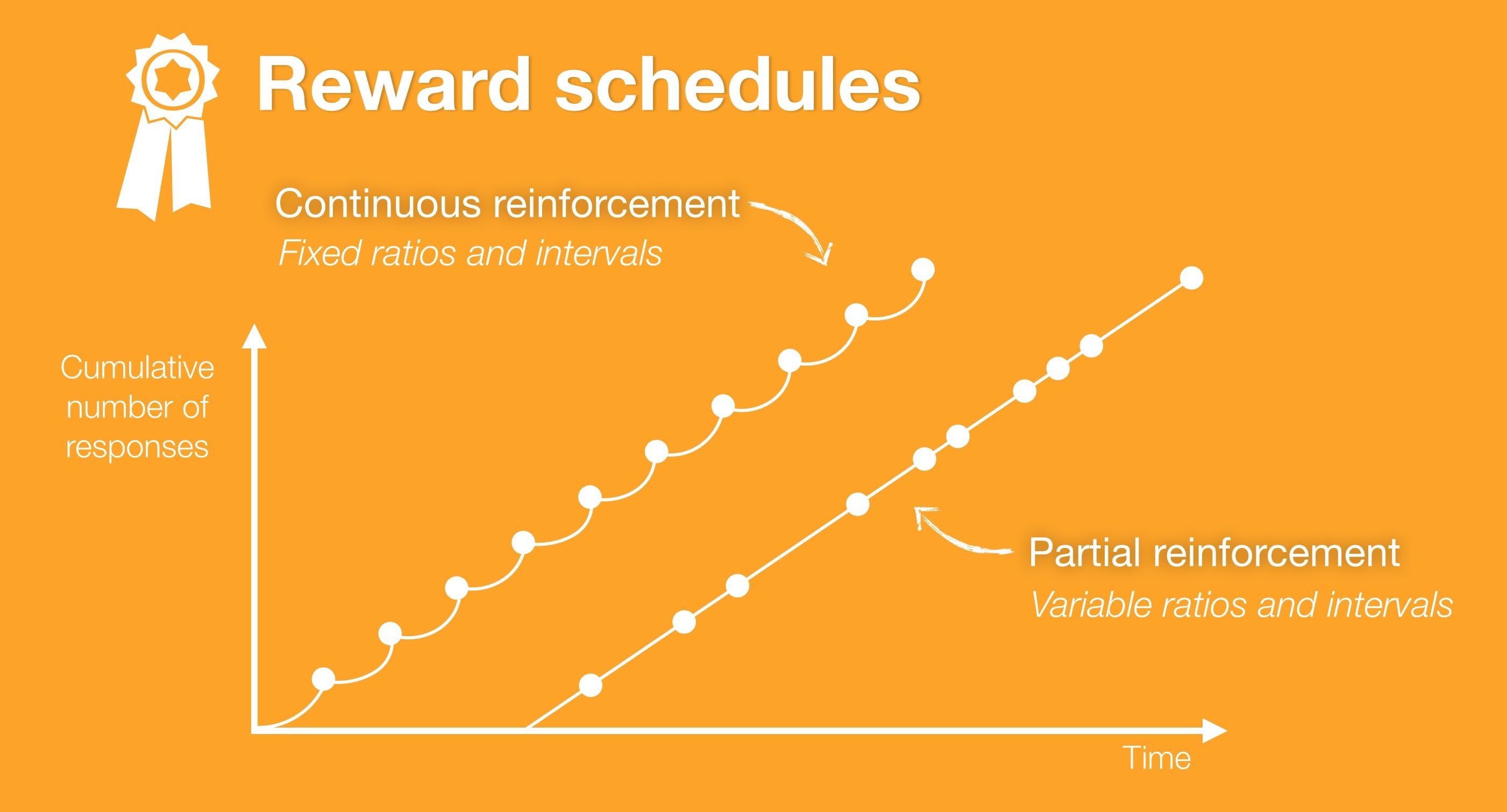
The activity level of users is a function of how soon they expect a reward to be given. The more certain they are that something good or interesting will happen soon, the more activity they will produce. When users know a reward is a long way off, the motivation is low and so is user activity.
This is typically seen with the fixed reward schedules of continuous reinforcement, where users are rewarded again and again with a fixed ratio or interval.
Immediately after a reward has been given, activity drops and only starts to take off again, once a new reward comes closer.
The variable rewards of partial reinforcement, on the other hand, randomize rewards around an average. When not knowing when we are about to receive a reward, we tend to keep up our activity, even though a reward has just been given.
Partial reinforcement produce a much more stable activity level, that does not feature the cool down period of continuous reinforcement.
When planning your reward schedules, the first thing you have to consider is whether to plan for continous reinforcement or partial reinforcement. Once decided, the next dimension is whether to reinforce along the number of responses or along amount of time. With ratios or with intervals.
Continous reinforcement is planned with fixed ratios and intervals, where partial reinforcements are planned with variable ratios and intervals. In cases where you are specifically trying to teach a new behavior, a continuous schedule is often a good choice. Once the behavior has been learned, switching to a partial schedule is often preferable.
Partial schedules not only tend to lead to behaviors, that are more resistant to extinction, they also reduce the risk, that the subject will become satiated. If the reward being used is no longer desired or rewarding, the subject may stop performing the desired behavior
When we receive a reward planned after fixed ratios and intervals, we immediately experience a feeling of the next reward being a long way from now, which in turn lowers our activity level.
With rewards planned after variable ratios and intervals, we never know exactly when to expect a reward, why we tend to expect it anytime soon. This leads to a higher level of activity all together.
Getting rewards right
Everyone likes to be told, they are doing a good job, but for rewards to work effectively, they need to be given at the right time and in the right amount – and then it’s essential and that you are giving the right reward
Ask these questions for each opportune moment, to determine what is right:
- What rewards is the system giving at the moment? Can it give out others as well? Are other forms of rewards ore effective?
- How are the rewards of the system building? The right amount is critical, and need to match the expectations and capabilities of the user.
- Are rewards building up Too fast? Too slow? Or just right? If the user can’t catch up, he or she will become satiated, and the reinforced behavior will go to extinction.
- Are users excited, when they receive rewards or bored by them? And why is this?
There is only one way to figure out the right balance of time, amount, and kind of reward: through trial and error.
Balancing rewards is often a question of “good enough”.
Learn more
This article is an excerpt of an online video course on Designing Engaging User Experiences taught by Anders Toxboe.